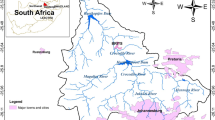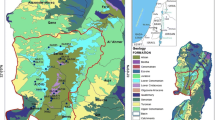Abstract
The current water supply for the city of Sete Lagoas, Brazil, is almost entirely groundwater from the Sete Lagoas Karst Aquifer, with a small contribution from a fractured-basement rock aquifer. Characterizing the hydrogeologic processes is important for proper water resource management, avoiding contamination and other future issues. The main goal of this study is to identify active hydrogeological processes, such as possible surface–ground water interactions, sources of recharge, and the hydrochemical evolution of groundwater through the use of stable isotopes 18O and 2H and major ion data. The groundwater samples were collected from the karst aquifer (central urban area) and from the fractured aquifer (southern part of the city). Surface water samples were collected from the seven main lakes, and rainwater was sampled over a period of one year. The stable isotope results indicated the groundwater origin is directly from local precipitation, having a limited recharge period, and locally receiving surface water contributions. Groundwater quality in the central urban area may be influenced by surface water infiltration where the karst aquifer is in contact with overlying unconsolidated sediments. Some samples with nitrate concentration of 10 mg/L or higher indicates the natural composition of the groundwater has been altered by urban sewage contamination. The highest concentrations of major ions were found in the central region, where the most karstified area from the Sete Lagoas Formation is located. These data suggest a longer residence time for this water, indicating more mineralization, in accordance with the geological information.












Similar content being viewed by others
References
Alaburda JE, Nishihara L (1998) Presence of nitrogen compounds in well water. J Public Health 32(2):160–165
Andreo B, Vías J, Durán JJ, Jiménez P, López Geta JA, Carrasco F (2008) Methodology for groundwater recharge assessment in carbonate aquifers: application to pilot sites in southern Spain. Hydrogeol J 16:911–925
Appelo CAJ, Postma D (2005) Geochemistry, groundwater and pollution, 2nd edn. A.A. Balkema, Leiden, The Netherlands
Batiot C, Emblanch C, Blavoux B (2003) Carbone organique total et magnésium: deux traceurs complémentaires du temps de séjour dans l’aquifere karstique. Académie des sciences, éditions scientifiques. Elsevier: 205–214
Branco Jr, Costa MT (1961) Belo Horizonte-Brasilia roadmap tour. In: Brazilian Congress of Geology, Brasilia. Radioactive Research Institute, Federal University of Minas Gerais (UFMG), Publication 15, Belo Horizonte, p 25
Buttle JM (1994) Isotope hydrograph separations and rapid delivery of pre-event water from drainage basins. Prog Phys Geogr 18(1):16–41
Cartwright I, Weaver TR, Fulton S, Nichol C, Reid M, Cheng X (2004) Hydrogeochemical and isotopic constraints on the origins of dryland and salinity, Murray Basin, Victoria, Australia. Appl Geochem 19(8):123–1254
CETESB (1998) Sampling and water samples preservation guide. São Paulo
Clark I, Fritz P (1997) Environmental isotopes in hydrogeology. CRC Press, New York
Coplen TB, Kendall C (2000) Stable hydrogen and oxygen isotope rations for selected sites of the U.S. Geological Survey’s NASQAN and Benchmark Surface-Water Networks: I.S. Geological Survey Open-File Report 00-160
Craig H (1961) Standard for reporting concentration of deuterium and oxygen-18 in natural waters. Science 133:1702–1703
Custodio E, Llamas MR (1983) Hidrologia subterranea. Ômega, v. 2., Barcelona
Custodio E, Llamas MR (2001) Hidrologia subterrânea. Tomo I e II, Ediciones Omega, S.A., Barcelona
Farfán H, Corvea JL, de Bustamante I (2009) Sensitivity analysis of APLIS method to compute spatial variability of karst aquifers recharge at the national Park of Viñales (Cuba). Adv Res Karst Media Environ Earth Sci 2010:19–24
Feng W, Banner JL, Guilfoyle A, Musgrove M, James EW (2012) Oxygen isotopic fractionation between drip water and speleothem calcite: a 10-year monitoring study, central Texas, USA. Chem Geol 304–305:53–67
Fontes DC (1980) Environmental isotopes in groundwater hydrology. In: Fritz P, Fones JC (eds) Handbook of environmental isotopes geochemistry, vol 1. Elsevier, New York, pp 75–140
Ford DC (1999) Perspectives in karst hydrogeology and cavers genesis. In: Palmer AR, Palmer MV, Sasowsky ID (eds) Karst modeling. Karst Waters Institute Special Publication no 5, Charlottesville, pp 17–29
Ford DC, Williams PW (1989) Karst geomorphology and hydrology. Unwin Hyman, Boston
Foster SSD, Hirata RCA (1987) Groundwater pollution risk evaluation: the methodology using available data. WHO/PAHO/HPE/CEPIS, Lima, p 87
Freeze AR, Cherry JA (1979) Groundwater. Prentice-Hall, Englewood Cliffs, New Jersey
Galvão P, Halihan T, Hirata R (2015a) Evaluating karst geotechnical risk in the urbanized area of Sete Lagoas, Minas Gerais, Brazil. Hydrogeol J 23(7):1499–1513
Galvão P, Halihan T, Hirata R (2015b) The karst permeability scale effect of Sete Lagoas, MG, Brazil. J Hydrol 531:85/15-105. doi:10.1016/j.jhydrol.2015.11.026
Galvão P, Hirata R, Cordeiro A, Osório DB, Peñaranda J (2016) Geologic conceptual model of the municipality of Sete Lagoas (MG, Brazil) and the surroundings. Anais da Academia Brasileira de Ciências 88(1):35–53
Gibson JJ, Edwards TWD, Birks SJ, St Amour NA, Buhay WM, McEachern P, Wolfe BB, Peters DL (2005) Progress in isotope tracer hydrology in Canada. Hydrol Process 19(1):303–327
Ginsberg M, Palmer AN (2002) Delineation of source-water protection areas in karst aquifers of the Ridge and Valley and Appalachian Plateaus physiographic provinces: rules of thumb for estimating the capture zones of springs and wells. Unpublished report EPA 816-R-02-015, 51p. US Environmental ProtectionAgency, Office of Water. Available from http://www.epa.gov/safewater
Goldsheider N, Drew D (2007) Methods in karst hydrology. Taylor & Francis Group, London
Han Z, Tang C, Wu P, Zhang R, Zhang C (2014) Using stable isotopes and major ions to identify hydrological processes and geochemical characteristics in a typical karstic basin, Guizhou, southwest China. Isot Environ Health Stud 50(1):62–73
Harris DM, McDonnell JJ, Rodhe A (1995) Hydrograph separation using continuous open system isotope mixing. Water Resour Res 31(1):157–171
Hess JW, Wells SG, Quinlan JF, White WB (1989) Hydrogeology of the south-central Kentucky karst. In: White WB, White EL (eds) Karst hydrology concepts the Mammoth Cave area. Van Nostrand Reinhold, New York, p 15.63
Hounslow AW (1995) Water quality data: analysis and interpretation. CRC Lewis Publishers, Boca Raton, pp 86–87
IAEA/WHO (2004) Global network of isotopes in precipitation. The GNIP Database. Available at http://isohis.iaea.org
IBGE—Brazilian Institute of Geography and Statistics (2015) Basic municipal information. Available http://www.cidades.ibge.gov.br/xtras/perfil.php?lang=&codmun=316720&search=minas-gerais|sete-lagoas. Accessed on Oct 2015
Karamouz M, Ahmadi A, Akhbari M (2011) Groundwater hydrology engineering, planning, and management. CRC Press, Taylor and Francis Group, Boca Raton, London, New York, pp. 31–35, 578
Käss W, Behrens H, Himmelsbach T, Hötzl H (1998) Tracing technique in geohydrology. Balkema, Rotterdam
Katz BG, Lee TM, Plummer LM, Busenberg E (1995) Chemical evolution of groundwater near a sinkhole lake, northern Florida; 1. Flow patterns, age of groundwater, and influence of lake water leakage. Water Resour Res 31(6):1549–1564
Kennedy VC, Kendall C, Zellweger GW, Wyerman TA, Avanzino RJ (1986) Determination of the components of stormflow using water chemistry and environmental Isotopes, Mattole River Basin, California. J Hydrol 84(1–2):107–140
Lee KS, Kim Y (2007) Determining the seasonality of groundwater recharge using water isotopes: a case study from the upper North Han River basin, Korea. Environ Geol 52(5):853–859
Li SL, Liu CQ, Li J, Lang YC, Ding H, Li L (2010) Geochemistry of dissolved inorganic carbon and carbonate weathering in a small typical karstic catchment of Southwest China: isotopic and chemical constraints. Chem Geol 277:301–309
Liu L, Shu L, Chen X, Oromo T (2009) The hydrologic function and behavior of the Houzhai underground river basin, Guizhou Province, southwestern China. Hydrogeol J 18:509–518
Machavaram MV, Whittemore DO, Conrad ME, Miller NL (2006) Precipitation induced stream flow: an event based chemical and isotopic study of a small stream in the Great Plains region of the USA. J Hydrol 330(3–4):470–480
McKenna SA, Ingraham NL, Jacobson RL, Cochran GF (1992) A stable isotope study of bank storage mechanisms in the Truckee river basin. J Hydrol 134(1–4):203–219
Moore CH (1989) Carbonate diagenesis and porosity. Development in sedimentology 46. Elsevier, Amsterdam
Mudry J (1987) Apport du traçage physico-chimique naturel à la connaissance hydrocinematique des aquifères carbonates. Mémoire n4 Univ. Besançon
O’Driscoll MA, DeWalle DR, McGuire KJ, Gburek WJ (2005) Seasonal O-18 variations and groundwater recharge for three landscape types in central Pennsylvania, USA. J Hydrol 303(1–4):108–124
Palmer AN (1991) Origin and morphology of limestone caves. Geol Soc Am Bull 103:1–21
Pessoa P (1996) Hydrogeological characterization of the region of Sete Lagoas - MG: Potentials and Risks. Master Thesis. Department of Geosciences, University of São Paulo. São Paulo
Piper AM (1944) A graphical procedure in the geochemical interpretation of water-analysis. Trans Am Geophys Union 25:914–928
Plagnes V (1997) Le transport de matière dans les aquifères karstiques. 6th conf on limestone hydrology and fissured media, La Chaux de Fond, Suisse, 14-18/08/97:179-183
Plummer LN, Busenberg E, McConnell JB, Drenkard S, Schlosser P, Michel RL (1998) Flow of river water into a karstic limestone aquifer. Tracing the young fraction in groundwater mixtures in the upper Floridan aquifer near Valdosta, Georgia. Appl Geochem 13(8):995–1015. doi:10.1016/S0883-2927(98)00031-6
Puls RW, Barcelona MJ (1996) Low flow (minimal drawndown) groundwater sampling procedures. United States Environmental Protection Agency, Office of Research and Development, Office of Solid Waste and Emergency Response, EPA/540/S-95/504, April
Rozanski K, Araguás-Araguás L, Gonfiantini R (1993) Isotopic patters in modern global precipitation. In: Swart PK et al (eds) Climate change in continental isotopic records, Geophysical Monograph Series 78, AGU, Washington, pp 1–36
Ryan M, Meiman J (1996) An examination of short-term variation in water quality at the karst spring in Kentucky. Ground Water 34(1):23–30. doi:10.1111/j.1745-6584.1996.tb01861.x
Sappa G, Barbieri M, Ergul S, Ferranti F (2012) Hydrogeological conceptual model of groundwater from carbonate aquifers using environmental isotopes (18O, 2H) and chemical tracers: a case study in southern Latium region, Central Italy. J Water Resour Prot 4:695–716
Silveira CS, Silva Junior GC (2002) The use of environmental isotopes in hydrogeological studies in Brazil: a critical review. Yearbook of the Institute of Geosciences - UFRJ. Vol. 25
Souza E, Galvao P, Almeida R, Pinheiro C, Baessa M, Cabral M (2015) Stable isotopes studies in the Urucu Oil Province, Amazon Region, Brazil. J Water Resour Prot 7:131–142. doi:10.4236/jwarp.2015.73011
Tonietto SN (2010) Diagenesis and hydrothermal rocks in Proterozoic carbonates: Bambuí and Vazante Groups, São Francisco Basin. Master Thesis. Institute of Geosciences, University of Brasília. Federal District
Winston WE, Criss RE (2003) Oxygen isotope and geochemical variations in the Missouri River. Environ Geol 43(5):546–556
Wong C, Kromann JS, Hunt BB, Smith BA, Banner JL (2013) Investigating groundwater flow between Edwards and Trinity Aquifers in Central Texas. Groundwater 52:624–639. doi:10.1111/gwat.12106
Zhao M, Zeng C, Liu Z, Wang S (2010) Effect of different land use/land cover on karst hydrogeochemistry: a paired catchment study of Chenqi and Dengzhanhe, Puding, Guizhou, SW China. J Hydrol 388:121–130
Acknowledgements
This work was funded by Servmar Environmental & Engineering and by São Paulo Research Foundation (FAPESP) [Fundação de Amparo à Pesquisa do Estado de São Paulo] (process 2012/12846-9). Special thanks go to Sete Lagoas’ Water Supply and Sewage Service (SAAE) [Serviço Autônomo de Água e Esgoto].
Author information
Authors and Affiliations
Corresponding author
Rights and permissions
About this article
Cite this article
Galvão, P., Hirata, R., Halihan, T. et al. Recharge sources and hydrochemical evolution of an urban karst aquifer, Sete Lagoas, MG, Brazil. Environ Earth Sci 76, 159 (2017). https://doi.org/10.1007/s12665-017-6482-3
Received:
Accepted:
Published:
DOI: https://doi.org/10.1007/s12665-017-6482-3




